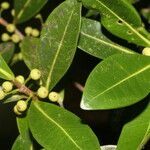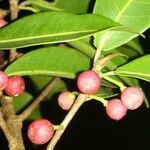Tree up to 20 m tall. Branchlets 1.5-3 mm thick, minutely puberulous to glabrous. Stipules 0.6-1.2 cm long, glabrous; petiole 0.5-1 cm long; blade coriaceous, elliptic, 1.5-4.5 x 0.5-2 cm, apex acuminate to acute, base rounded to subacute, glabrous above and beneath; secondary veins 8-10 pairs, prominent on both sides. Figs in pairs in the leaf axils, globose, 0.3-0.5 cm in diam., at maturity red to pink; peduncle 0.1-0.2 cm long; basal bracts ca. 1.5 mm long; ostiole ca. 1.5 mm in diam., plane to sligthly prominent.
A fig. It is a shrub or tree. It can be 30 m tall. The trunk can be 30 cm across. The leaves are 2-8 cm long by 1-4 cm wide. The figs occur in pairs in the axils of leaves. They are 3-7 mm across.







